
 |
Spring is finally here and my goodness has it been a quiet one with not much in the way of proper aurora activity and absolutely zero convective opportunities. The weather has been for the most part dry with returning high pressure, occasional sunny days then cloud, this seemed to be the cycle for a long time, but combine that with chilly NEly then Nly breezes and for the most part it has never felt very warm, as a consequence there was nothing of interest to chase or photograph.
That all changed on March 28th when we finally had one single day of convective potential so I was definitely going to take advantage of it. GFS had picked up on this five days out and amazingly the target day never changed, if anything it actually upgraded closer to the time so 24 hours before March 28th I had a good look at the charts, I can tell you it feels great to be studying the models again, I had been waiting all Winter for these days to finally arrive. This was a post-frontal cool air mass set-up with SBCAPE of 100 and 300-400j/kg of MLCAPE on a NWly flow with cloud tops between -20c and -30c. A trough would pass through earlier in the day acting as a source of lift, and this combined with surface heating would be the main sources of lift for convection. The only concern was that the trough and maximum CAPE values would peak early at noon to 13.00 before rapidly waning as instability and the trough moved eastward so we wouldn't be benefiting from prime solar heating, however with sunrise at 07.00 we still had plenty of insolation to help out.
The other complication was shear, charts showed modest low level shear exceeding 20 knots however DLS was crazy between 60 and 80 knots, such shear could form highly organized convection however the majority of this shear stayed out W trailing the trough so there would be no major engagement. That being said I did notice an overlap in afternoon with the leading sector of this DLS interacting with the waning instability so this could compensate. The other concern was cell velocity, given the shear and the blustery 20mph sfc showers and storms would be fast moving hence not hanging around for long, a trait I don't like to see in a forecast, however I wasn't going to be fussy so early in the season, I was grateful for a chance of anything at all. My conclusion was that the best overlap of parameters would be over the E and NE of Co. Antrim due to the better timing. I wasn't prepared to drive to that area this time due to the CAPE leaving quickly so I decided on a more neutral location, Lough Neagh.
From the shore of the largest inland lake in the UK we would have a perfect view across Co. Antrim and being so open and flat we would have unrestricted views of storm bases and a greater chance of spotting funnels. Furthermore the models showed cells passing over that area so it seemed a decent spot, I said 'we' because Portglenone storm chaser Colleen Webb was also chasing. She too was eager to catch her first convection of Spring and get the new chase season off to a good start so we decided we would meet at Ballyronan Marina for a few hours. I honestly had very low expectations, I just wanted to see vertical clouds again, my goal was simple, I wanted to capture a nice cell over the lough and I would be content enough.
That morning a radar checked revealed more showers than expected in line with the GFS so this was a good sign. The day was breezy but very sunny and weak convective clouds could be seen to the W/NW even at 10.00. I packed the gear into the van and drove to Ballyronan Marina and arrived just before 11.00, early for a chase day but we needed to be for this particular set-up. Colleen was already on location scanning the skies and checking radar. It really was a gorgeous day at the lough shore with great sunshine and beautiful clear water with quaking ducks and swans. An hour later we were beginning to doubt this day had anything to offer, the showers were very small in vertical extent and looked soft and mushy, it even looked like some sort of capping inversion was in place which I doubted given the cold air aloft, we would just have to let nature brew, things often change later.
Before 13.00 Colleen checked the radar and sferics charts and we both got a shock. Thunderstorms had already broken out all across the high ground of Co. Antrim with c-g lightning over the ocean then inland of Coleraine, all through Ballymoney, Ballymena, and over the Glens Of Antrim. Even though we didn't get these storms I was delighted to know about them for several reasons. First these validated my own personal forecast and confirmed the atmosphere was indeed capable of thunderstorms. Second, this fully supported the very area where I expected storms to break out in the first place once again validating my instincts and forecast, this was a good feeling and very satisfying. I really enjoy seeing the forecasts come to fruitation as much as experiencing the storms themselves.
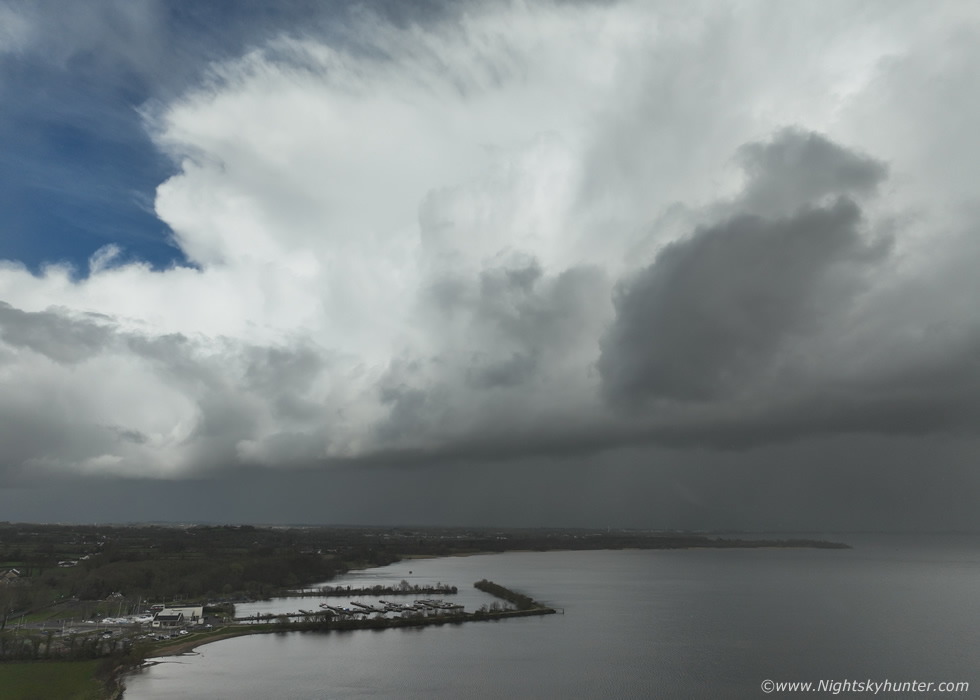 |
Half an hour later Colleen spotted a new storm on radar, this time to our NW over the W. Sperrins with a red core and it had produced lightning over the countryside near Strabane. I suspected the increasing shear was helping in this area, the cell which caused it was fast moving and was making a bee line for Lough Neagh, it was heading our way and given the strong shear aloft it would be with us in no time so cameras were at the ready.
Soon the white tops of the cell came into view over the NW portion of the lough and rapidly approaching us. We ran over to a clearing for a better view and got both drones in the air. A new area of precip was breaking out over the right flank. Gusts of wind blew the trees and triggered the usual wind speed warnings on the controllers but we stayed in the air, this didn't concern us. Here's an aerial view of the Strabane storm now passing over the lough, rain was falling on the drone from an overhead shower, then the sun broke through the clouds to reveal the flanking area.
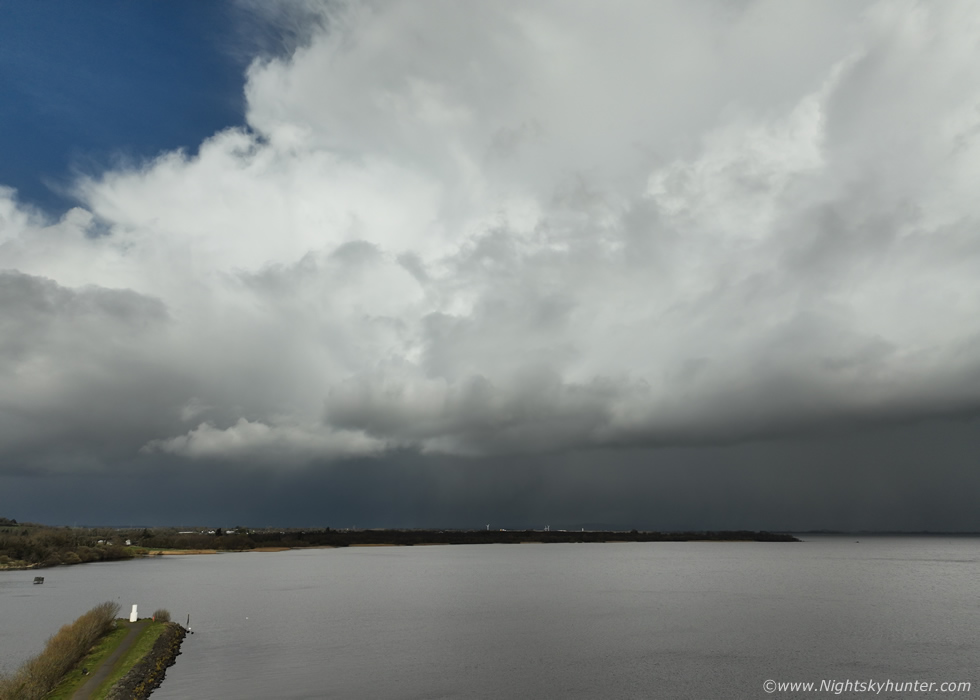 |
Two things became very obvious, this cell was moving fast, and it was growing bigger in height and horizontal extent and this wasn't just the decreasing distance, the cell was getting big and mean. Flanking area and base now getting more solid with hints of hail in the precip curtain coming into view, facing N along the pier.
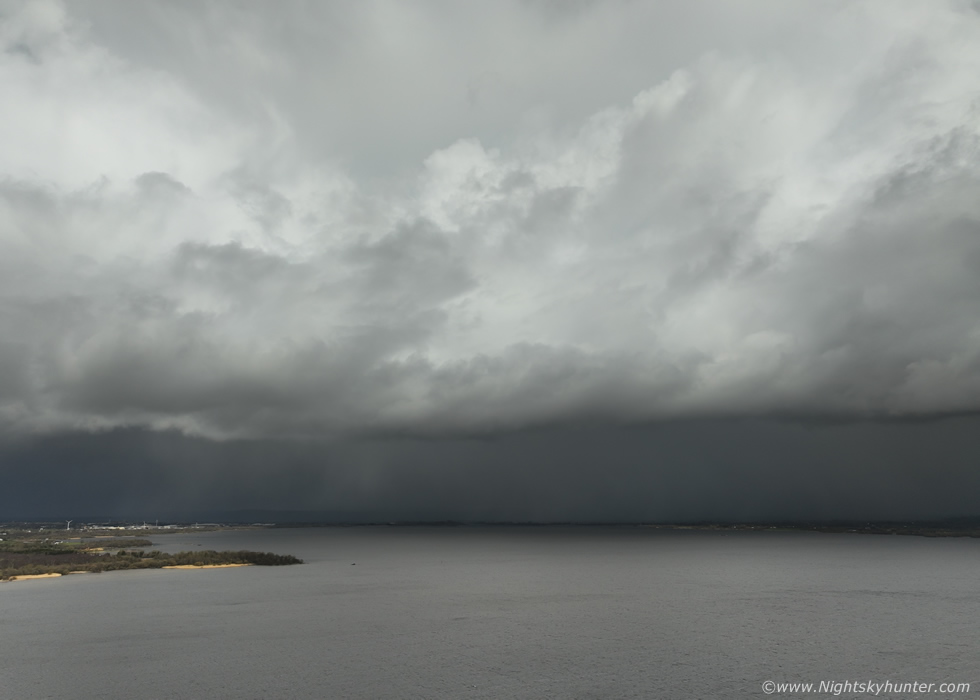 |
Visually this was a mean sky with dark grey core and sunlit white chunky convective clouds, it looked like a new thunderstorm growing, we were honestly expecting a rumble any minute.
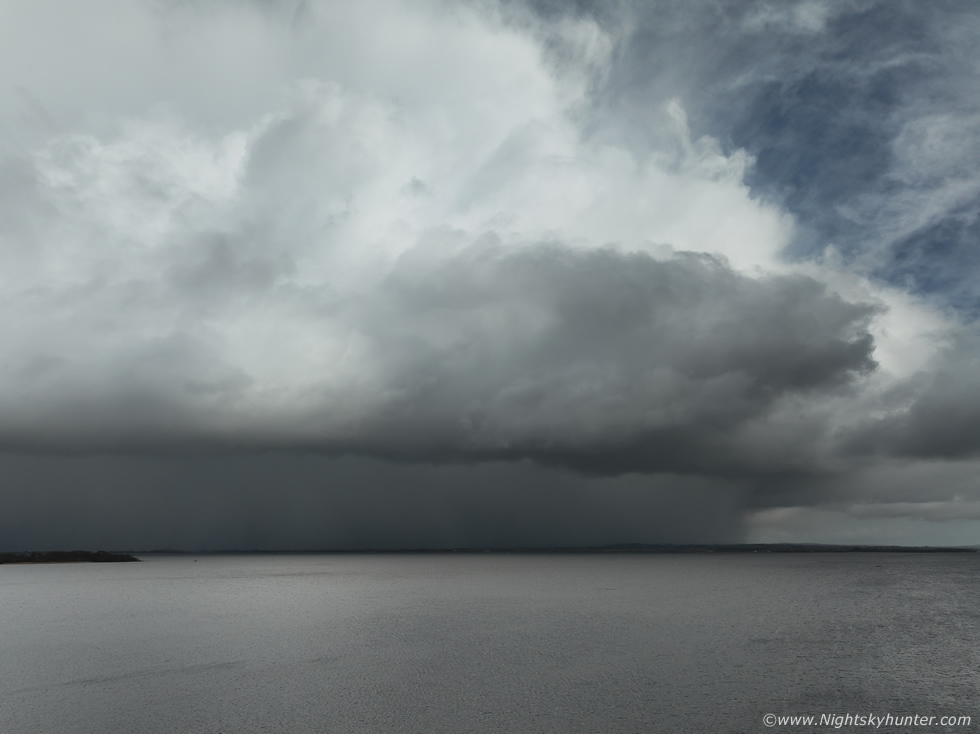 |
At this stage we were delighted, this was acually getting impressive and quite cool looking, our first close range convective cell of Spring, I had already achieved my goal. At this stage it looked like a thunderstorm, outflow winds were buffeting the trees and drones and sending surface waves flying across the top of the lough, the precip core was dense and white on radar and the leading edge became very well defined. The cell stretched across the entire northern portion of the lough.
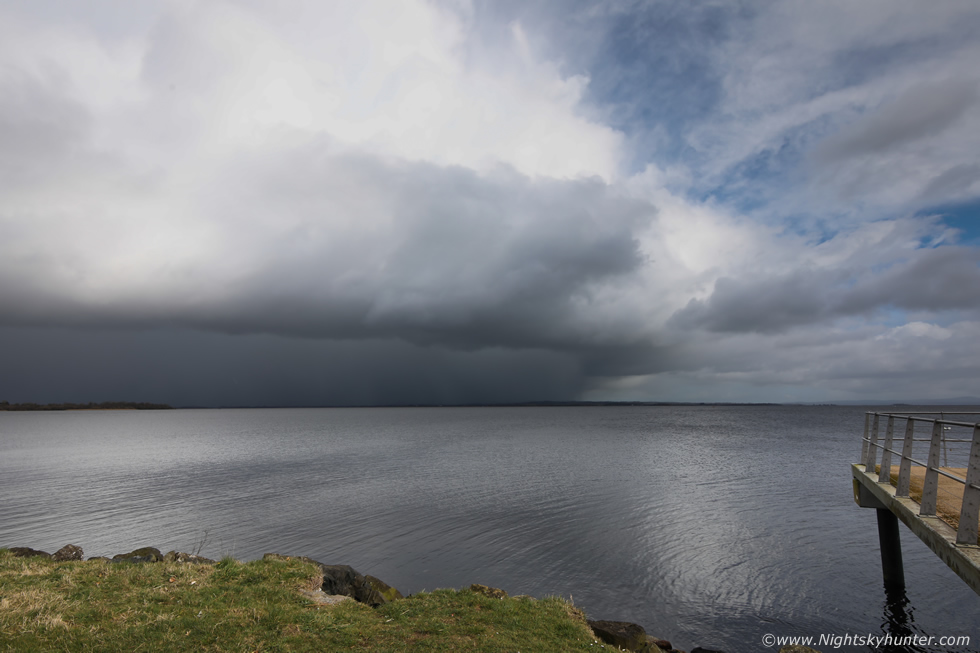 |
I let the drone hover recording video in case a c-g struck, then grabbed the DSLR for higher res wide angle ground captures. The pier actually came in handy for providing a great sense of scale with foreground interest.
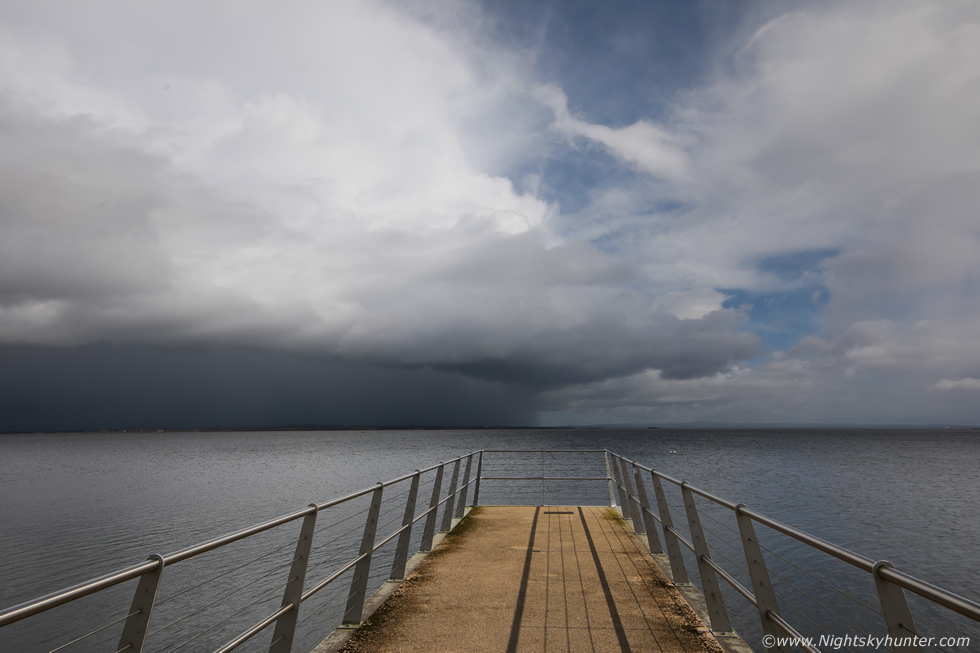 |
Standing on the pier, I really want to repeat this scene with a massive multicell or waterspout.
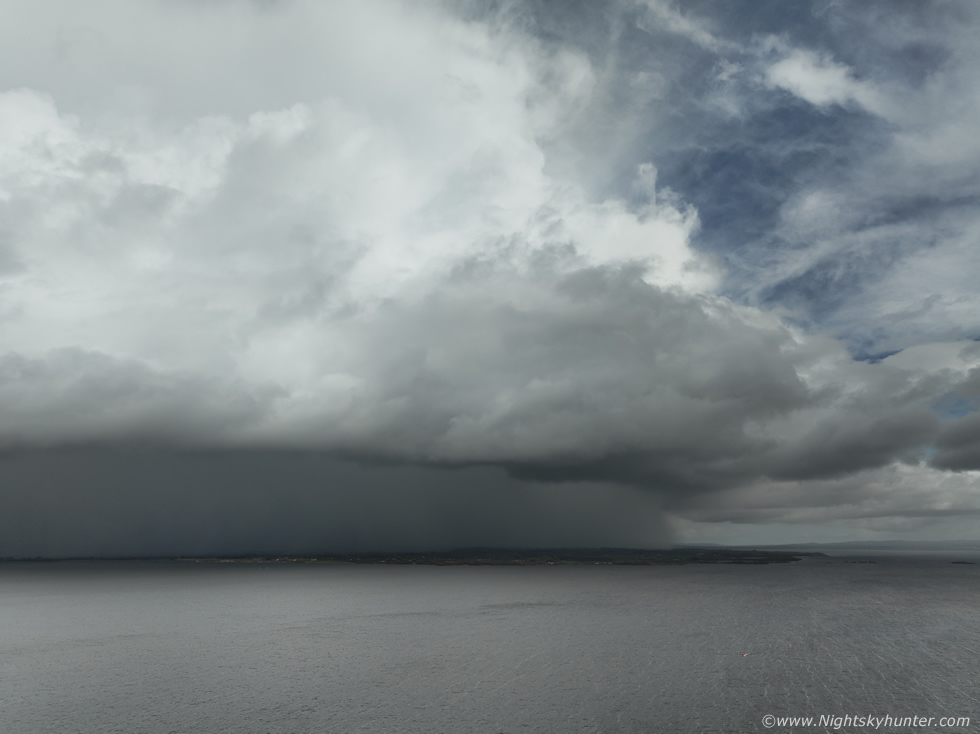 |
Drone wide angle still, check out the footage below showing a pan from this section all away back to the NW revealing the full size of this cell. Wind warnings on the controllers continued as outflow blasted across the lough, there where reports from Antrim of intense hail falls.
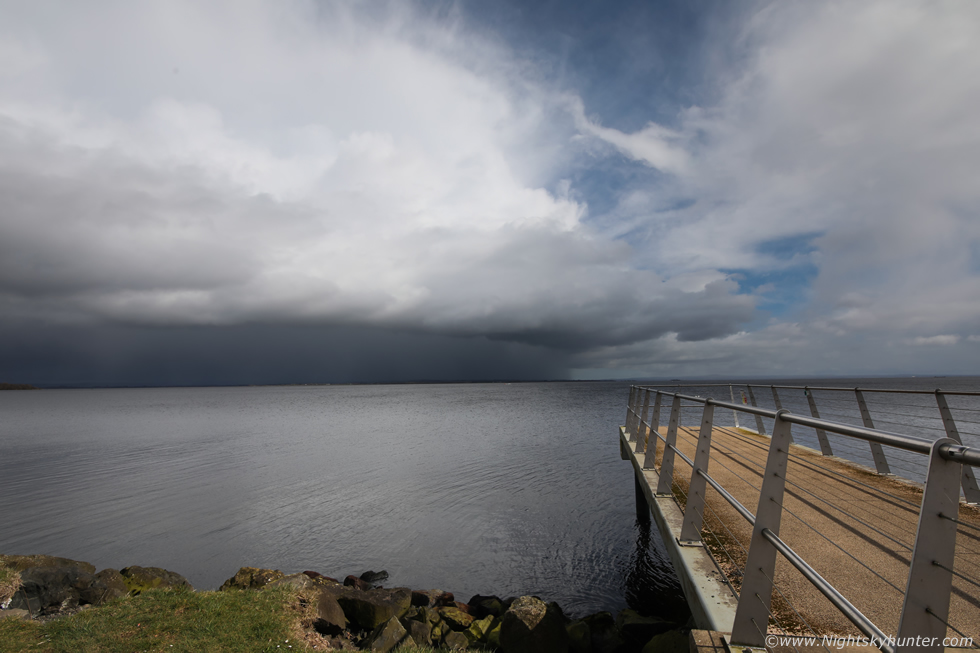 |
Final ground shot, 15mm wide angle on full frame as the cell transitioned over land at Co. Antrim where it would continue for some time with red cores on radar. We where still shocked at the lack of thunder, the cell really looked the part and was just as strong on radar as the earlier storms over E. Antrim, but still we were delighted to get anything convective for so early in the season, in fact, this was beyond my expectations for today so I was more than happy with how things worked out. Two more big showers where following our target cell and advancing rapidly behind us, we where going to get soaked and with no time to leg it back to the cars we ended up seeking shelter under this pier.
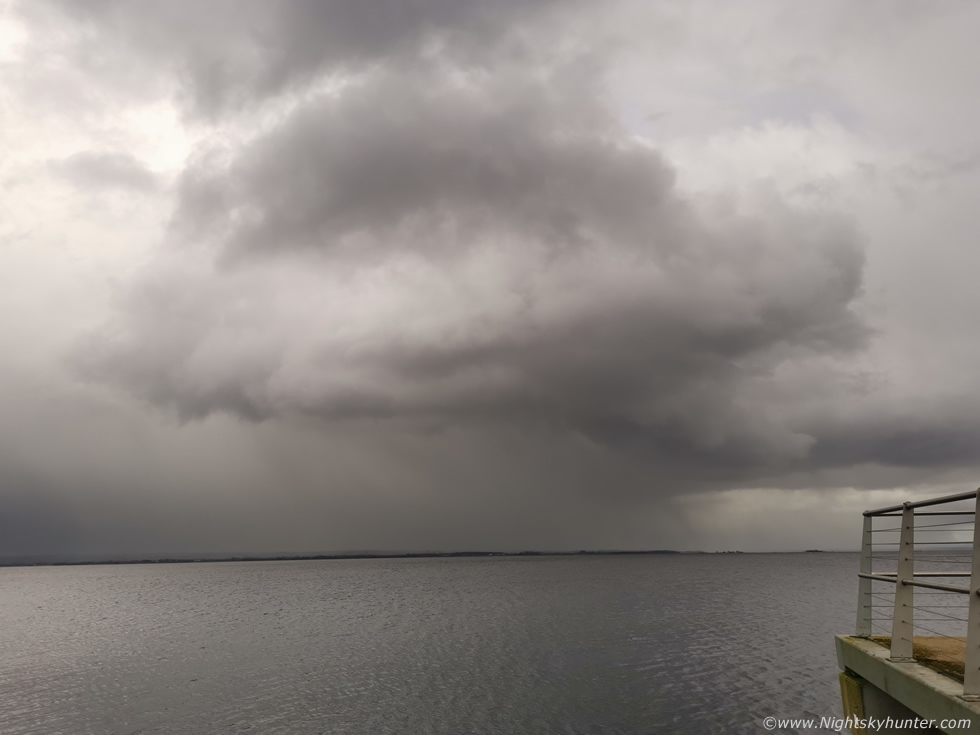 |
Once the rain passed over us we emerged from under the pier to view the back end of the second shower which in itself looked quite beefy, this was an image taken with the mobile phone.
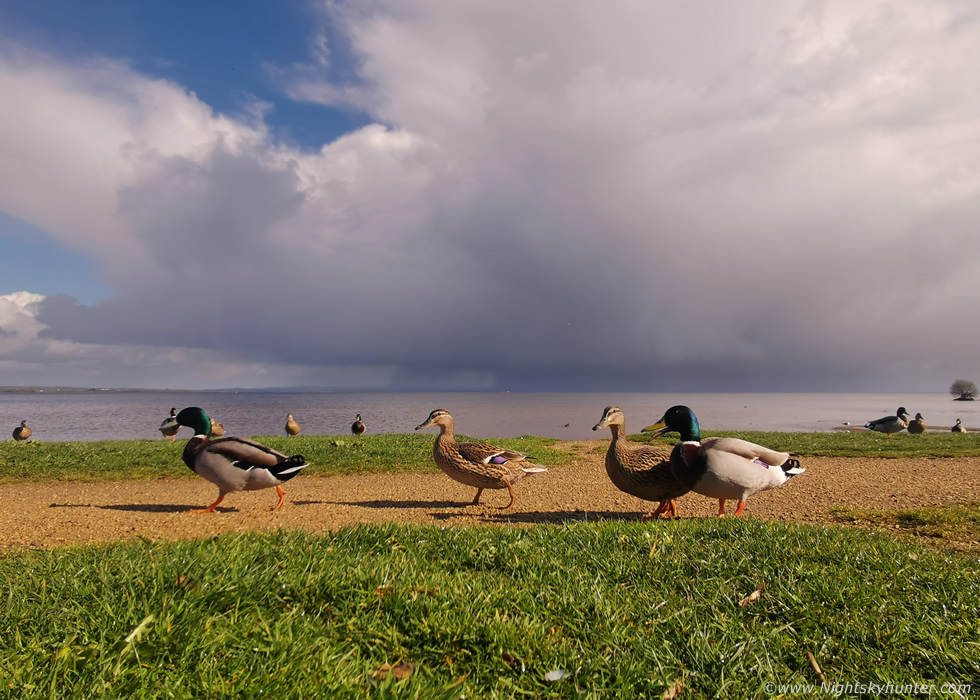 |
The instability weakened, the clouds cleared and by mid afternoon the sun was blazing and once again the marina was back to looking like a tourist resort. The ducks came out quaking and made for some fun foreground interest as the last hail shower in the entire sky drifted away across the lough. It was a fun day out which Colleen and I enjoyed very much, however on the down side these teaser days tend to get one fired up wanting more chase days but with high pressure dominating the forecast for the considerable future convection will be unlikely, we could be waiting until late April or May before we get another chance so this brief taste will have to keep us going until then.
The following morning, March 29th, there would be a partial eclipse of the sun across N. Ireland with more than 40% of the sun's disk covered by the moon so it would be a substantial enough bite worthy of observing and I was very much looking forward to seeing it. However, you guessed it, it was 100% cloudy with rain from a weak warm front so I never seen a thing, the peak eclipse was at 11.00 but the sun only showed itself at 15.00 when the event was long over. However, I didn't mind missing this one if we can get clear skies for the next partial eclipse which would take place in August 2026, in fact, this likely will be the best partial solar eclipse we will ever see in our life time and extremely photogenic with a crescent sun visible in the western sky an hour or two before sunset during prime Summer, it has all the hall marks of being a spectacular sight so I'm very much looking forward to that.
Nature began to waken once again with several interesting observing and photogenic prospects which got my attention. First of all a large area of Saharan dust had advected across large areas of UK and Ireland in conjunction with a great spell of prolonged high pressure weather. This meant hazier skies which increased the chances of capturing the sun's at sunset/sunrise which currently sported several large sunspot regions. The dust can also generate prolonged sunset afterglows. A solar wind stream was also buffeting the Earth's magnetosphere stirring up periodic mild G1 storming for several days, however during daylight of April 5th G2 conditions were reached thanks to a CIR region stirring things up.
If these weren't enough to warrant a photo shoot news arrived of a newly discovered comet which had just been found using SOHO's SWAN camera which detects the hydrogen comae of comets which sport a particularly strong signature. The comet hadn't even been properly named yet and it's orbit hadn't been nailed down either so this was really early days. Thanks to posts on the MPML several observers were getting it at mag +10.5 and brightening. It was visible in the pre-dawn sky and so low it would require a proper telescopic hunt in the countryside with a clear horizon so this became high on my list.
On Friday April 5th a photo shoot was arranged. With high pressure the weather was fabulous and mild with strong sunshine and such a joy to be out in. During the evening I met up with Colleen Webb, Paul Martin and Conor McDonald at Lough Fea with the intention of shooting the sunset. Amazingly one cloud hung over the sun blocking our view the entire time, so attention then turned to the aurora. Stats were not great, solar wind average, Bz-2 and jumping from time to time, the sky was hazy and we had a waxing moon near first quarter riding very high in the western sky thanks to the steep angle of the ecliptic. We gathered alongside the water's edge with cameras watching and waiting, we picked up a faint low green and purple glow on camera but nothing dramatic and visually there was nothing to see at all so no score with the aurora. But that being said we had a great time watching the sky and taking test images with the cameras and enjoying nature which is always time well spent.
The aurora seemed dead and by midnight everyone had headed home. I was with Rhua my dog and my original plan was to drive back home then set the alarm for before dawn then drive back to Lough Fea to hunt down the comet. For some reason I decided I was going to do an all nighter, I would stick it out and wait for the comet to rise between 4am and 5am, it would be a long wait. I don't know what made me decide to stay but I had an instinct so I trusted that. I pulled into the side of the road beside the lough and turned off the engine and all lights and relaxed. Rhua was sleeping, the night was quiet and still, for an hour I sat in the driver's seat watching the stars. My eyes half closed, I fancied half an hour of sleep but couldn't find it so I opened my tired eyes and was shocked to see big naked eye beams of light towering above the road and over part of the lough, I thought I was dreaming, it was the aurora!, I looked at the time, it was 01.00.
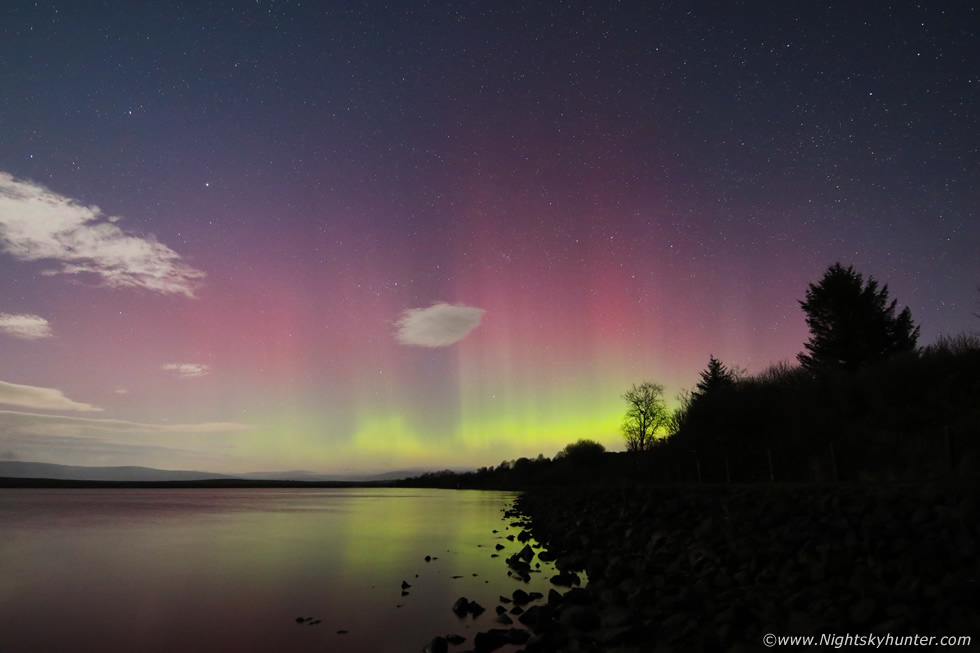 |
I ran outside, opened the door, grabbed the DSLR and tripod then ran through the moonlight to the rocky edge of the lough and took an exposure, ISO6400, 4 sec's at 15mm wide angle on full frame. This was beyond anything I had been expecting tonight, maybe if I was lucky I would get a green glow and one beam at best, but not 30 degree tall naked eye search lights reflecting on the water. As it turned out I was pleased with the image, some patches of small moonlit lenticular clouds hovered over the lake so I began shooting a time lapse.
 |
Another image a few minutes later, then suddenly just as quickly as it started the aurora faded away to a faint glow and the beams were gone, it was a brief outburst likely generated by a dip in the Bz but it made my night. My mind then turned to comet hunting, I drove to a secluded spot on a narrow back road barely wide enough for one car then reversed into the tree line out of sight among gorse bushes and waited.
The moonlit haze was worrying me, I likely would not see the comet in such conditions. By 04.00 low in the NE the constellation of Pegasus rose into view, the comet was located inside it's great square. The region of sky was only 10 degrees above the horizon and due to moonlight, haze and LP glow I could only see the principle naked eye stars of that constellation. I was already dark adapted for hours and trained my eyes on a few Messier objects such as M81, M82, M13, M92, M27 and M56. Feeling ready I began carefully sweeping the telescope through Pegasus.
After 20 min's of relentless careful scanning of every FOV I found the comet at 04.20 LT and I was absolutely overjoyed. It was a 9th magnitude oval smudge of light with no tail, and slightly brighter towards centre with a DC of 6. It may not have looked spectacular but this was a newly discovered comet and seeing it so soon after discovery was a thrill, especially knowing that you are among a small band of observers across the world who have seen it visually. This would be my 95th observed comet, I looked up from the eyepiece and there were faint ghostly pillars to the N, I grabbed the camera once more.
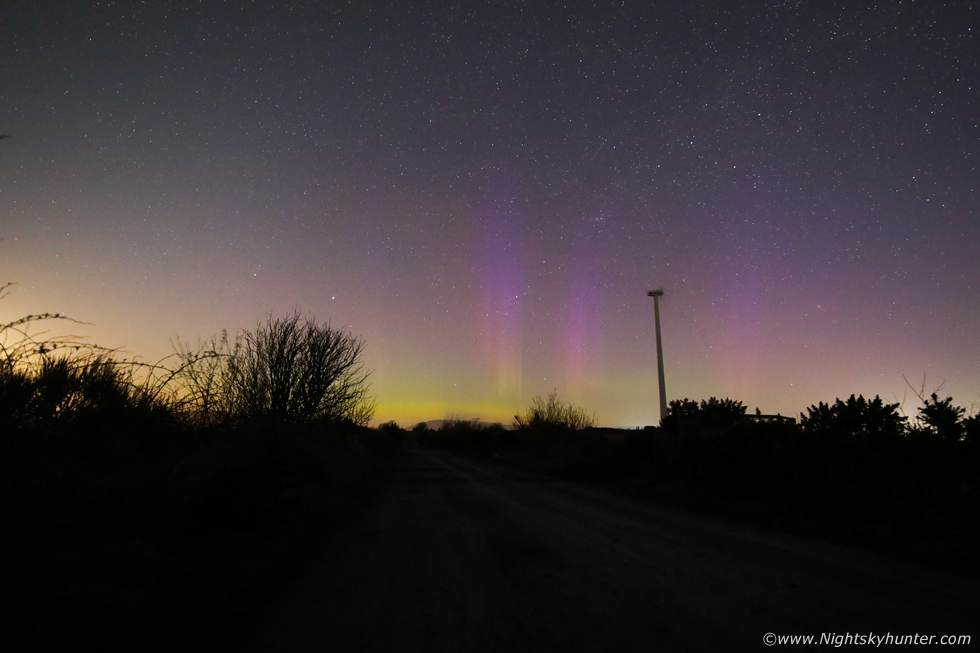 |
Pillars of translucent light pointed up from the horizon between Cassiopeia and Perseus, even though it wasn't as impressive as earlier it was such a cool moment to see a new comet and an aurora at the same time. It felt like nature was celebrating, I went back to the scope and alternated between the comet and aurora, I was having such a great time. At 05.00 I called it a night, this all nighter was a fun and highly rewarding personal experience. The comet would later be designated C/2025 F2 SWAN and the following morning I observed it again in outburst at mag +8.6 with a hint of blue colour. The new orbit indicates this is a long period comet which had been here before and would reach perihelion in May. By then it will be visible in the evening sky and a bright binocular object so I look forward to seeing it then.
Drone footage of the March 28th Lough Neagh cell showing its full horizontal extent. Little did I know after this night that a massive outbreak of wild fires would happen across N. Ireland and that I would be spending three days in a row chasing them so these will be the subject of my next reports. Thanks very much for reading.
Martin McKenna